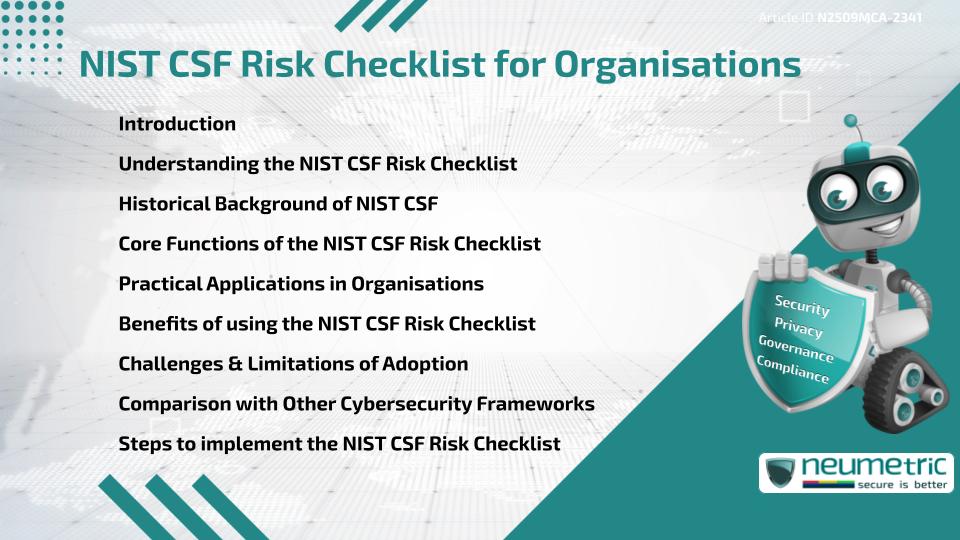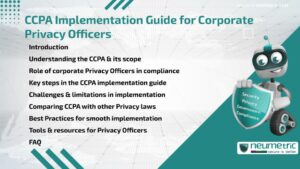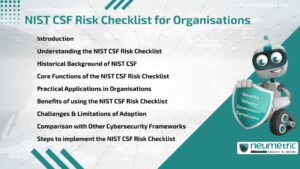Table of Contents
ToggleIntroduction
The NIST CSF Risk Checklist is a structured guide developed to help organisations manage Cybersecurity Threats effectively. Designed under the National Institute of Standards & Technology Cybersecurity Framework [NIST CSF], it outlines the essential steps for identifying, protecting, detecting, responding & recovering from cyber Risks. By following the checklist, organisations can align their security practices with recognised standards, reduce exposure to Threats & strengthen resilience. This article explains the origins of the NIST CSF Risk Checklist, its main components, its role in practical Business Operations, benefits, limitations & how it compares with other frameworks.
Understanding the NIST CSF Risk Checklist
The NIST CSF Risk Checklist is essentially a practical translation of the Cybersecurity Framework into actionable tasks. It offers a systematic way for organisations to assess & improve their Risk Management posture. Unlike generic Security Policies, the checklist provides specific items that organisations can validate, ensuring that no essential aspect of Cybersecurity Risk Management is overlooked.
Historical Background of NIST CSF
The NIST Cybersecurity Framework was first introduced in 2014 in response to increasing Cyber Threats affecting critical infrastructure in the United States. Developed in collaboration with Government agencies, industry leaders & academia, the Framework set out to create a common language for Cybersecurity. Over the years, it evolved into a widely accepted Standard beyond the US, with the NIST CSF Risk Checklist emerging as a practical tool for organisations of all sizes.
Core Functions of the NIST CSF Risk Checklist
The NIST CSF Risk Checklist is based on five (5) Core Functions:
- Identify – Understanding assets, Risks & Vulnerabilities
- Protect – Implementing safeguards to secure Systems & Data
- Detect – Monitoring for irregularities & potential breaches
- Respond – Acting on Threats in a timely & coordinated manner
- Recover – Restoring systems & services after an incident
These functions create a holistic cycle that supports Continuous Improvement & resilience in Cybersecurity practices.
Practical Applications in Organisations
Organisations use the NIST CSF Risk Checklist as a benchmark to test existing security programs. For example, a hospital may use it to ensure compliance with health information standards, while a Financial firm may adopt it to protect sensitive Customer Data. The checklist also helps Small Businesses by offering a structured starting point for Cybersecurity, reducing the overwhelm of technical complexity.
Benefits of using the NIST CSF Risk Checklist
There are several advantages to adopting the NIST CSF Risk Checklist:
- Provides a universal Framework recognised across industries
- Helps identify Security Gaps & prioritise improvements
- Strengthens compliance with regulations & audits
- Enhances organisational resilience against cyber incidents
- Promotes consistent communication across technical & executive teams
Challenges & Limitations of Adoption
Despite its strengths, the NIST CSF Risk Checklist is not without challenges. Smaller organisations may struggle with the resources required to meet every item on the list. In some cases, the checklist can feel overly broad, requiring adaptation to specific business contexts. Additionally, the checklist does not eliminate Risks but rather helps manage them, which means organisations must remain vigilant.
Comparison with Other Cybersecurity Frameworks
Compared with frameworks such as ISO 27001 or CIS Controls, the NIST CSF Risk Checklist is more flexible & less prescriptive. ISO 27001 requires certification, whereas the NIST checklist acts as a guideline. CIS Controls provide a narrower set of technical Best Practices, while the NIST CSF takes a higher-level view, making it more adaptable for different industries.
Steps to implement the NIST CSF Risk Checklist
Adopting the checklist typically follows these steps:
- Assess current Cybersecurity posture by identifying strengths & weaknesses.
- Prioritise actions based on Risks & available resources.
- Develop a roadmap aligned with the five (5) NIST CSF functions.
- Implement controls & safeguards according to identified priorities.
- Review & monitor progress through periodic reassessments.
Organisations often find that gradual implementation leads to more sustainable results compared to attempting full adoption at once.
Takeaways
The NIST CSF Risk Checklist is a versatile & widely recognised tool that enables organisations to address Cybersecurity systematically. While it requires effort & adaptation, its benefits in improving Risk awareness, compliance & resilience outweigh its challenges.
FAQ
What is the NIST CSF Risk Checklist?
It is a structured guide based on the NIST Cybersecurity Framework that helps organisations manage Cybersecurity Risks.
Why should organisations use the NIST CSF Risk Checklist?
It ensures that all critical aspects of Risk Management are addressed, improves compliance & builds resilience against Threats.
How does the NIST CSF Risk Checklist differ from ISO 27001?
ISO 27001 is certification-based, while the NIST checklist serves as a guideline without formal Certification requirements.
Can Small Businesses use the NIST CSF Risk Checklist?
Yes, it is adaptable for organisations of all sizes, though smaller firms may need to prioritise key elements due to resource constraints.
Does the NIST CSF Risk Checklist guarantee full protection from Cyber Threats?
No, it helps manage & reduce Risks but cannot eliminate them entirely.
Is the NIST CSF Risk Checklist industry-specific?
No, it was designed to be flexible & applicable across multiple industries, including Healthcare, Finance & Manufacturing.
How often should organisations review their NIST CSF Risk Checklist implementation?
Regular reviews are recommended, typically annually or after significant organisational changes or Security Incidents.
Need help for Security, Privacy, Governance & VAPT?
Neumetric provides organisations the necessary help to achieve their Cybersecurity, Compliance, Governance, Privacy, Certifications & Pentesting needs.
Organisations & Businesses, specifically those which provide SaaS & AI Solutions in the Fintech, BFSI & other regulated sectors, usually need a Cybersecurity Partner for meeting & maintaining the ongoing Security & Privacy needs & requirements of their Enterprise Clients & Privacy conscious Customers.
SOC 2, ISO 27001, ISO 42001, NIST, HIPAA, HECVAT, EU GDPR are some of the Frameworks that are served by Fusion – a SaaS, multimodular, multitenant, centralised, automated, Cybersecurity & Compliance Management system.
Neumetric also provides Expert Services for technical security which covers VAPT for Web Applications, APIs, iOS & Android Mobile Apps, Security Testing for AWS & other Cloud Environments & Cloud Infrastructure & other similar scopes.
Reach out to us by Email or filling out the Contact Form…





